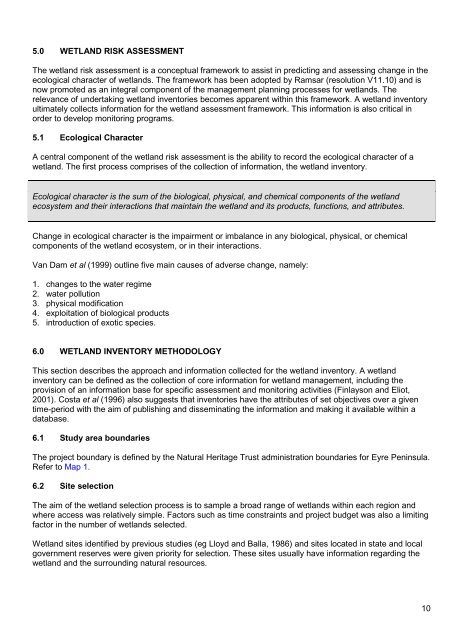2007 Wetland Inventory for the Eyre Peninsula
2007 Wetland Inventory for the Eyre Peninsula
2007 Wetland Inventory for the Eyre Peninsula
- No tags were found...
You also want an ePaper? Increase the reach of your titles
YUMPU automatically turns print PDFs into web optimized ePapers that Google loves.
5.0 WETLAND RISK ASSESSMENTThe wetland risk assessment is a conceptual framework to assist in predicting and assessing change in <strong>the</strong>ecological character of wetlands. The framework has been adopted by Ramsar (resolution V11.10) and isnow promoted as an integral component of <strong>the</strong> management planning processes <strong>for</strong> wetlands. Therelevance of undertaking wetland inventories becomes apparent within this framework. A wetland inventoryultimately collects in<strong>for</strong>mation <strong>for</strong> <strong>the</strong> wetland assessment framework. This in<strong>for</strong>mation is also critical inorder to develop monitoring programs.5.1 Ecological CharacterA central component of <strong>the</strong> wetland risk assessment is <strong>the</strong> ability to record <strong>the</strong> ecological character of awetland. The first process comprises of <strong>the</strong> collection of in<strong>for</strong>mation, <strong>the</strong> wetland inventory.Ecological character is <strong>the</strong> sum of <strong>the</strong> biological, physical, and chemical components of <strong>the</strong> wetlandecosystem and <strong>the</strong>ir interactions that maintain <strong>the</strong> wetland and its products, functions, and attributes.Change in ecological character is <strong>the</strong> impairment or imbalance in any biological, physical, or chemicalcomponents of <strong>the</strong> wetland ecosystem, or in <strong>the</strong>ir interactions.Van Dam et al (1999) outline five main causes of adverse change, namely:1. changes to <strong>the</strong> water regime2. water pollution3. physical modification4. exploitation of biological products5. introduction of exotic species.6.0 WETLAND INVENTORY METHODOLOGYThis section describes <strong>the</strong> approach and in<strong>for</strong>mation collected <strong>for</strong> <strong>the</strong> wetland inventory. A wetlandinventory can be defined as <strong>the</strong> collection of core in<strong>for</strong>mation <strong>for</strong> wetland management, including <strong>the</strong>provision of an in<strong>for</strong>mation base <strong>for</strong> specific assessment and monitoring activities (Finlayson and Eliot,2001). Costa et al (1996) also suggests that inventories have <strong>the</strong> attributes of set objectives over a giventime-period with <strong>the</strong> aim of publishing and disseminating <strong>the</strong> in<strong>for</strong>mation and making it available within adatabase.6.1 Study area boundariesThe project boundary is defined by <strong>the</strong> Natural Heritage Trust administration boundaries <strong>for</strong> <strong>Eyre</strong> <strong>Peninsula</strong>.Refer to Map 1.6.2 Site selectionThe aim of <strong>the</strong> wetland selection process is to sample a broad range of wetlands within each region andwhere access was relatively simple. Factors such as time constraints and project budget was also a limitingfactor in <strong>the</strong> number of wetlands selected.<strong>Wetland</strong> sites identified by previous studies (eg Lloyd and Balla, 1986) and sites located in state and localgovernment reserves were given priority <strong>for</strong> selection. These sites usually have in<strong>for</strong>mation regarding <strong>the</strong>wetland and <strong>the</strong> surrounding natural resources.10
















